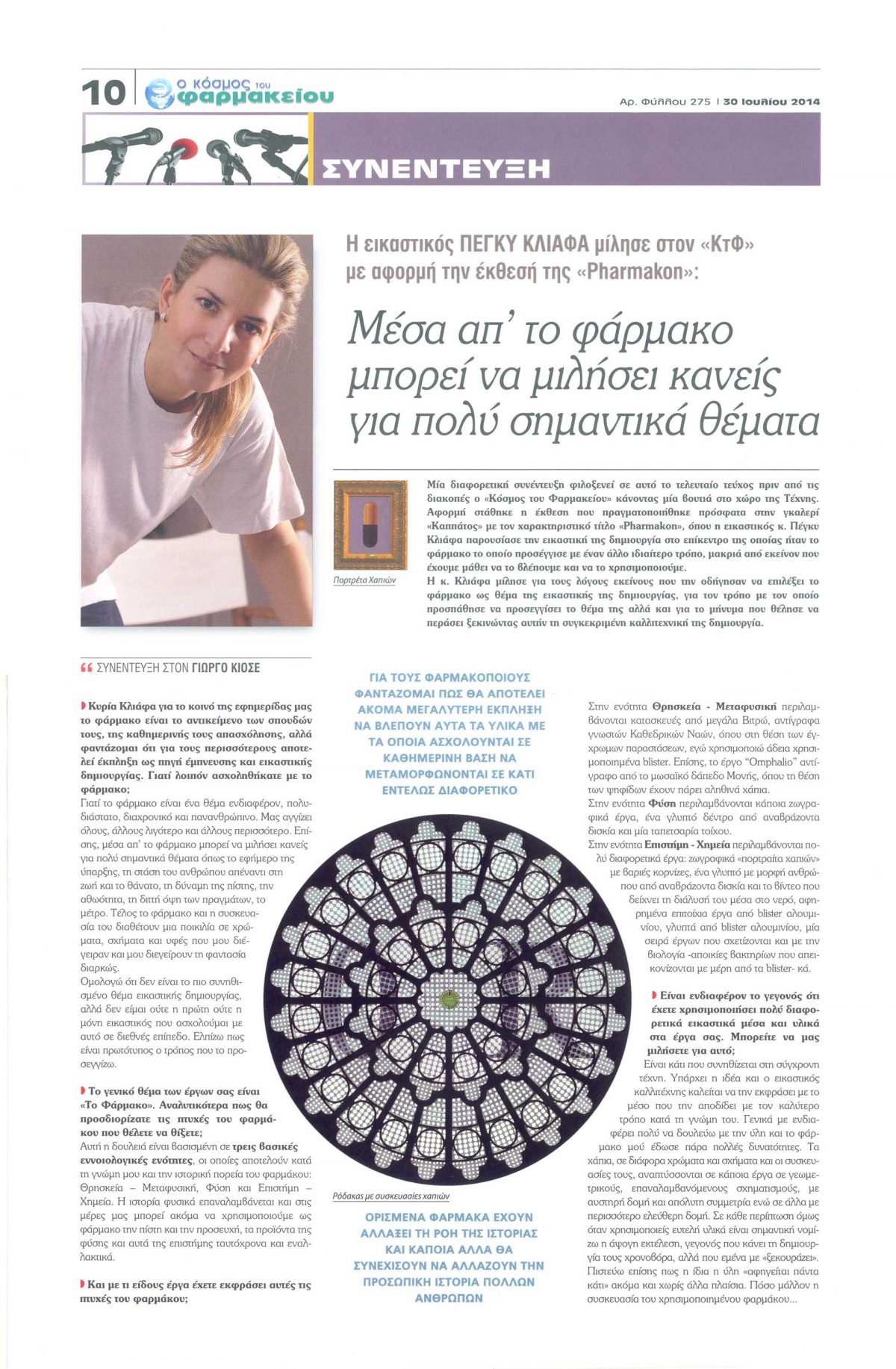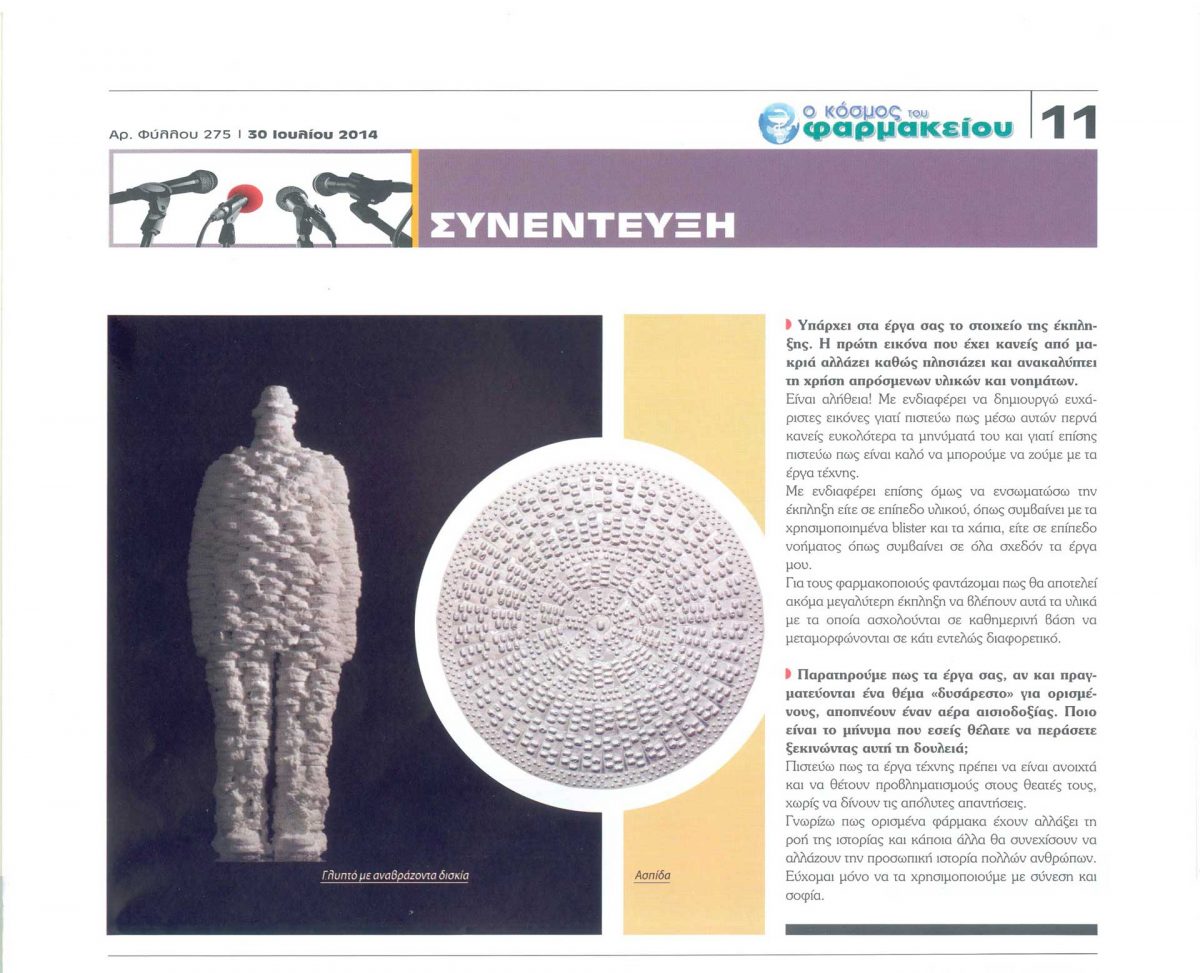Pharmacy’s World – Interview
Pharmacy’s World, issue 275, July 30, 2014
Interview
The visual artist Peggy Kliafa spoke to The World of the Pharmacy for her show, “Pharmakon”:
Through the medicine one can speak of very important subjects
Taking a plunge into the world of art, The World of the Pharmacy hosts a different kind of interview in this last issue before the holidays. The occasion is an exhibition recently mounted at Kappatos Gallery, entitled “Pharmakon”, showcasing work by the visual artist Peggy Kliafa, which revolves around the medicine, approached in a unique way, very different from the way in which we are accustomed to see it and use it.
Peggy Kliafa spoke about the reasons that made her choose the medicine as the subject matter of her creative work, about the way she approached her topic, as well as about what she sought to convey through this project.
Interview to Giorgos Kiosses
Mrs. Kliafa, for the audience of our newspaper, medicine is their subject of study, their daily occupation, yet I believe that for most it will be quite a surprise as a source of inspiration for a visual artist. What made you become involved with the medicine?
The medicine is an interesting, multifaceted, timeless and universal subject. It touches everyone to a different degree. Moreover, through the medicine one can treat very important issues, such as the ephemeral nature of existence, our stance visavis life and death, the power of faith, innocence, the dual nature of things, moderation. Finally, the medicine and pharmaceutical packaging come in a variety of colours, forms and textures that have always excited my imagination. I acknowledge that this may not be the most common subject for a visual artist, but I am neither the first nor the only artist involved with it internationally. I hope, however, that I approach it in an original manner.
The overall theme of your work is “Pharmakon”. Could you expand on the aspects of the medicine that you seek to treat?
This project is based on three main conceptual entities, which reflect in my view the historical evolution of the medicine: Religion-Metaphysics, Nature and Science-Chemistry. Of course, history repeats itself, and nowadays we may still use faith and prayer, natural products, and the products of science as medicines alternatively and simultaneously.
In what kinds of works have you conveyed these aspects of the medicine?
The series “Religion-Metaphysics” comprises constructions of large-scale stained-glass windows, copies after windows in well-known cathedrals, where empty, discarded blister packages are used in place of colour compositions. In addition, Omphalio is a copy after a mosaic floor in a monastery, where actual pills are used as tesserae.
The series “Nature” includes paintings, a sculpture of a tree made of effervescent tablets and a wall paper.
The series “Science-Chemistry” brings together some very different works: painting portraits of pills, in heavy frames, a sculpture of a male figure made of effervescent pills, and a video showing how it dissolves in water, abstract works on the wall made of foil blisters, sculptures made of foil blisters, a series of works also related to biology (bacteria colonies depicted using blister packaging).
Interestingly, you have been using very different media in your work. Could you talk to us about this?
This is common in contemporary art. There comes an idea, and the visual artist must express it through the medium that best conveys it in his/her opinion. I am generally very interested in working with different media, and medicines gave me various possibilities. Pills, in different colours and shapes, and their packaging, are employed in some of the art works in geometrical, repeated patterns, meticulously organised and absolutely symmetrical, while in other artworks there is a looser structure. In any case, when one uses worthless materials the quality of execution becomes important, I think; this makes their creation time-consuming, but I find that relaxing. I also believe that the material itself “always narrates something” even outside of other contexts. All the more so, the packaging of used medicines.
There is an element of surprise in your works. The first impression one forms from a distance changes when up close, discovering the use of surprising media and ideas.
This is true! I seek to create pleasant images, as I feel that one’s messages are easier to convey through them; I also believe that it is good to be able to live with works of art.
I am moreover interested in introducing an element of surprise either in the medium itself, as is the case with discarded blister packaging and pills, or in the meaning, as is the case in nearly all my work.
I imagine that it will be an even bigger surprise for pharmacists to see the materials with which they are involved on a daily basis morph into something entirely different.
We note that your works, althrough treating what for some people is an “unpleasant” topic, convey optimism. What is the message that you have sought to get across when you started this project?
I believe that works of art must be open-ended and pose questions without providing absolute answers.
I know that certain medicines have changed the course of history, and others will continue to change many people’s personal histories. I only wish that we may use them with moderation and wisdom.
Portraits of pills
A rosette of pill packaging
A sculpture of effervescent pills
Shield
Motto
I imagine that it will be even more of a surprise for pharmacists to see the materials with which they are occupied on a daily basis morph into something entirely different
Some medicines have changed the course of history; others will continue to change the personal histories of many people

